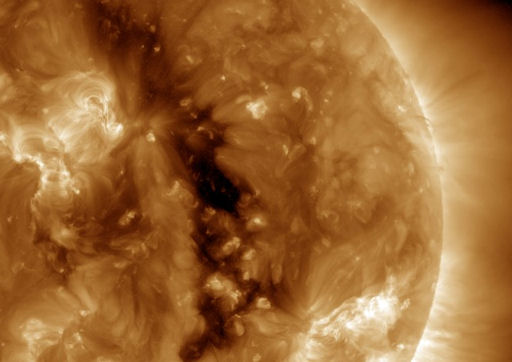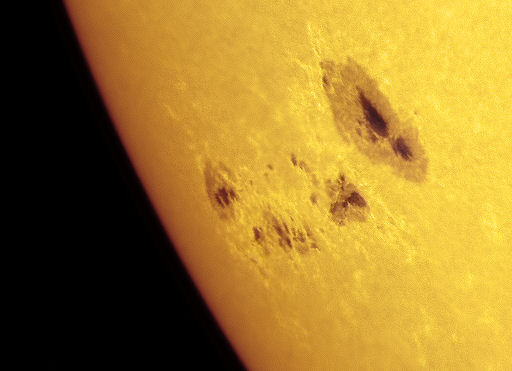TWO INCOMING CMEs: A pair of solar eruptions on May 7th hurled coronal masss ejections (CMEs) toward Earth. Forecast tracks prepared by analysts at the Goddard Space Weather Lab suggests that clouds with arrive in succession on May 9th at 13:40 UT and May 10th at 07:54 UT (+/- 7 hours). The double impact could spark moderate geomagnetic storms. High-latitude sky watchers should be alert for auroras. Magnetic storm alerts: text, phone.
CORONAL HOLE: A dark hole in the sun's atmosphere (a 'coronal hole') is spewing a stream of solar wind toward Earth. The impact of the stream, expected on May 9-11, could add to the effect of the incoming CMEs, boosting the chances of strong geomagnetic activity later this week. NASA's Solar Dynamics Observatory took this picture of the opening on May 8th:
Coronal holes are places where the sun's global magnetic field opens up and allows some of the sun's atmosphere to escape. The outflow of gas is the solar wind. NOAA forecasters estimate a 40% chance of geomagnetic activity on May 9-10 when the stream arrives (along with the CMEs of May 7th).
BIG SUNSPOT: One of the largest sunspot groups in years rotated over the sun's northeastern limb on May 6th. With a least four dark cores larger than Earth, AR1476 sprawls more than 100,000 km from end to end, and makes an easy target for backyard solar telescopes. Amateur astronomer Alan Friedman sends this picture of the behemoth from his backyard in Buffalo, NY:
"AR1476 is firecrackler," says Friedman.
Indeed, the active region is crackling with impulsive M-class solar flares. Based on the sunspot's complex 'beta-gamma' magnetic field, NOAA forecasters estimate a 75% chance of more M-flares during the next 24 hours. There is also a 10% chance of powerful X-flares.
"This one is going to be fun as it turns to face us!" predicts
Friedman. He might be right. Solar flare alerts: text, phone.
more images: from John Chumack of Dayton, Ohio; from Dave Gradwell of Birr, Ireland; from Dave Gradwell of Birr, Ireland; from Robert Arnold of Isle of Skye, Scotland; from Howard Eskildsen of Ocala, Florida; from Peter Desypris of Athens, Greece; from Erika Rix of Liberty Hill, Texas

![]()
Solar wind
speed: 361.9 km/sec
density: 3.4 protons/cm3
explanation | more data
Updated: Today at 1646 UT
![]()
X-ray Solar Flares
6-hr max: M1 1308 UT May08
24-hr: M1 1308 UT May08
explanation | more data
Updated: Today at: 1600 UT
![]()
![]()
![]()
Daily Sun: 08 May 12
![]()
![]()
Sunspot 1476 poses a threat for strong M-class solar flares. Credit: SDO/HMI
![]()
![]()
![]()
Sunspot number: 79
What is the sunspot number?
Updated 07 May 2012
Spotless Days
Current Stretch: 0 days
2012 total: 0 days (0%)
2011 total: 2 days (<1%)
2010 total: 51 days (14%)
2009 total: 260 days (71%)
Since 2004: 821 days
Typical Solar Min: 486 days
Updated 07 May 2012
The Radio Sun
10.7 cm flux: 122 sfu
explanation | more data
Updated 07 May 2012
![]()
![]()
![]()
Current Auroral Oval:
![]()
Switch to: Europe, USA, New Zealand, Antarctica
Credit: NOAA/POES
![]()
![]()
![]()
Planetary K-index
Now: Kp= 2 quiet
24-hr max: Kp= 2 quiet
explanation | more data
![]()
Interplanetary Mag. Field
Btotal: 9.1 nT
Bz: 7.8 nT north
explanation | more data
Updated: Today at 1646 UT
![]()
![]()
![]()
Coronal Holes: 07 May 12
![]()
![]()
Solar wind flowing from this coronal hole should reach Earth on May 9-10. Credit: SDO/AIA.






